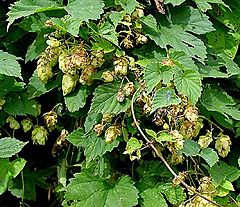Humulus facts for kids
Quick facts for kids Hop |
|
|---|---|
 |
|
| Common Hop plant (Humulus lupulus) | |
| Scientific classification | |
| Kingdom: | |
| Division: | |
| Class: | |
| Order: | |
| Family: | |
| Genus: |
Humulus
|
| Species | |
|
Humulus lupulus L. |
|
The Hop plant, also known as Humulus, is a cool type of flowering plant. It mostly grows in the northern hemisphere, which means the top half of our planet. The female flowers of the hop plant are often called cones because they look a bit like tiny pinecones. People use hops for many things, especially to add a special flavor and aroma to certain drinks.
- Humulus
Contents
The Amazing Hop Plant
The hop plant (Humulus) is a fascinating vine that loves to climb. It can grow very tall, sometimes reaching up to 25 feet (about 7.6 meters) in just one growing season! This plant is known for its special flowers, which look like small, papery cones.
What is a Hop Plant?
Hops are part of the Cannabaceae plant family. There are a few different kinds, or species, of hop plants. The most common one is called Humulus lupulus. Another well-known type is Humulus japonicus, also known as Japanese hop.
These plants are dioecious, which means each plant is either male or female. Only the female plants produce the special cone-like flowers that are used for different purposes.
Where Do Hops Grow?
Hop plants are native to many parts of the northern hemisphere. This includes regions in Europe, Asia, and North America. They prefer places with lots of sunshine and well-drained soil.
Hops are often grown on tall structures called trellises or wires. This helps the vines climb high and makes it easier to harvest the cones. Large fields of hops can look like tall green walls!
Parts of the Hop Plant
A hop plant has several important parts:
- Rhizomes: These are underground stems that help the plant spread and grow new shoots each year.
- Bines: Unlike vines that use tendrils to climb, hop plants have bines. Bines have stiff hairs that help them grip and climb upwards in a spiral motion.
- Leaves: The leaves are usually heart-shaped with jagged edges.
- Flowers (Cones): The most important part for many uses are the female flowers, often called "cones" or "strobiles." These cones contain tiny yellow glands filled with a substance called lupulin. Lupulin is what gives hops their unique flavor and aroma.
How Hops Are Used
Hops have been used for centuries for various reasons. Their main use today is in making certain drinks.
- Flavor and Aroma: Hops add a distinct bitter taste and a lovely aroma to drinks. This can range from floral and citrusy to earthy and spicy, depending on the hop variety.
- Preservation: Historically, hops were also used to help preserve drinks. The compounds in hops can help prevent spoilage.
- Other Uses: Beyond drinks, hops have been used in traditional medicine. Sometimes, young hop shoots are even eaten as a vegetable, similar to asparagus!
Growing Hops
Hop plants are perennials, meaning they live for many years. Each spring, new shoots grow from the underground rhizomes. The bines grow rapidly throughout the summer, climbing higher and higher.
The female plants produce their cones in late summer or early autumn. This is when the hops are harvested. After harvesting, the bines die back in the winter, and the plant rests until the next spring. This yearly cycle allows hop farms to produce new crops year after year.
Images for kids
See also
 In Spanish: Humulus para niños
In Spanish: Humulus para niños








